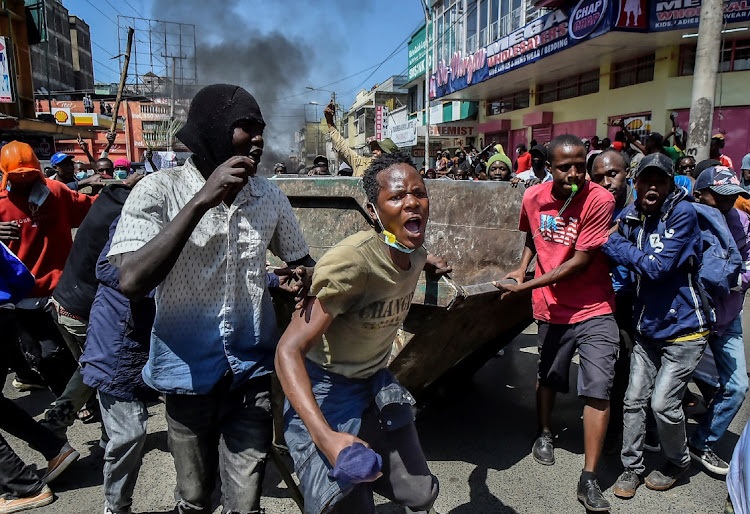At least 16 people have lost their lives and around 400 others have sustained injuries during a nationwide demonstration in Kenya that escalated into violence, on Wednesday, June 25, 2025, as thousands marched to commemorate those who died in last year’s anti-government protests.
Local media reports that the peaceful memorial turned chaotic with clashes erupting between police forces and protesters in multiple cities across the country.
Irũngũ Houghton, executive director of Amnesty Kenya, confirmed the death toll, citing verification from the government-funded Kenya National Commission on Human Rights.
“Most were killed by police,” he stated, underscoring the lethal force employed by authorities during the unrest.
A coalition of groups backing the demonstrations released a joint statement revealing that 83 individuals were seriously injured.
At least eight people receiving treatment for gunshot wounds.
The statement, issued by the Law Society of Kenya (LSK), the Police Reforms Working Group, and the Kenya Medical Association, called for calm and dialogue to resolve the political deadlock gripping the nation.
“We pray for our nation, dialogue and a way forward from the political impasse facing Kenya,” the statement read.
The protests were initially a tribute to the more than 60 victims who died last year when police opened fire on a crowd attempting to storm parliament as legislators debated controversial tax legislation.
The protestors demanded justice for those who lost their lives and accountability from the government.
Faith Odhiambo, president of the LSK, expressed the sorrow and frustration felt across the country.
“We face an unfortunate paradox as a country where more lives are being lost as the people seek justice for the lives already lost,” she wrote on social media platform X.
“Our hearts break for all the victims of the continued trend of police brutality and excesses.”
In Nairobi, police took extensive security measures to contain the protests.
Major roads near the central business district were barricaded, and buses and minibuses were turned away well before reaching the city center.
Access to critical locations, including parliament and the official residence of President William Ruto, was sealed off with razor wire.
Despite these restrictions, thousands gathered in the city’s heart, waving Kenyan flags and carrying placards bearing the faces of victims from last year’s unrest.
While many engaged peacefully, tensions escalated as some protesters lit street fires and chanted slogans targeting President Ruto.
Police responded with tear gas, water cannons, and batons, while demonstrators retaliated by throwing stones and other projectiles.
A medical source at Kenyatta National Hospital in Nairobi told Reuters that the facility had received 56 individuals, most suffering injuries from rubber bullets.
Similar violent confrontations between police and civilians broke out in other cities, including Mombasa, Nakuru, and Kisumu.
In Kiambu county’s Kikuyu town, protesters went as far as setting parts of court buildings on fire.
In a controversial move, Kenya’s Communications Authority ordered television and radio stations to cease live coverage of the demonstrations.
It threatened sanctions against those who defied the directive.
Major broadcasters such as NTV, KTN, K24, and Kameme were eventually taken off air.
Parliamentarians evacuated the parliament buildings amid the turmoil, while the protests intensified in Nairobi’s central areas.
Meanwhile, large crowds marched along major highways leading toward the capital, signaling widespread unrest.
The public outrage fueling these protests is rooted in long-standing grievances over corruption, unemployment, government overreach, and rising living costs.
Last year’s demonstrations, sparked by proposed tax hikes, resulted in dozens of deaths and numerous disappearances.
Although the street protests diminished over time, the cycle of killings, arrests, and forced disappearances continued, deepening public mistrust.
Two recent incidents this month have further ignited anger.
These were the death of teacher Albert Ojwang in police custody, reportedly after criticizing a senior police officer on social media, and the shooting of vendor Boniface Kariuki by police during a protest over Ojwang’s death.
Stephanie Marie, a young protester in Nairobi, said her presence at Wednesday’s march was inspired by Ojwang’s death.
“It could be my brother, it could be my cousin, it could be anyone,” she said.
“These are just normal boys, doing normal things.” She implored the government to listen to the voices of the people.
“The people voted. You’re here for the people.
“You’re working for the people … We just want you to listen to the people.
“That’s it.”
Another protester, Innocent, who was honoring a friend lost in last year’s unrest, recounted his experience with police tear gas during the day but said it would not deter him.
“The youth are unstoppable,” he affirmed.
“Because we’ve come to fight for our rights.”
He added, “We don’t want bad leadership.”
As Kenya grapples with ongoing political tension and widespread dissatisfaction, the protests and the government’s heavy-handed response have once again highlighted the urgent need for dialogue, reform, and respect for human rights.



